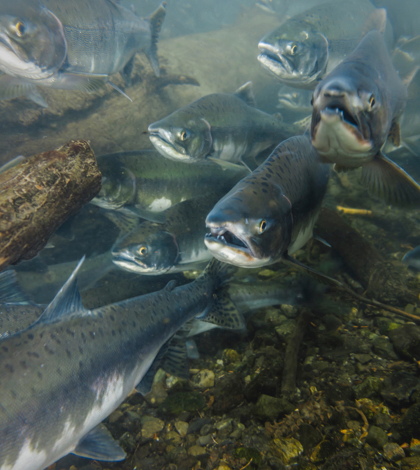Fish and Wildlife Contends Only a Small Portion of Baby Salmon are Involved
The Golden Gate Salmon Association (GGSA) has voiced their opposition to a decision by the California Department of Fish and Wildlife (CDFW) to abandon a successful trucking program that increases salmon survival and is instead dumping Feather River hatchery baby fall run salmon into supposedly predator-laden waterways as of this past Monday. The trucking program has proven especially critical during the state’s multi-year drought according to a statement by GGSA.
“Just last month at a salmon information meeting CDFW presented evidence that trucked Feather River fish were the major contributor to salmon caught by sport and commercial fishermen in the 2015 ocean fishing season,” said GGSA chairman Roger Thomas. “We can’t understand when they now want to take these fish away from us when we need them badly to stay in business.”
But according to Andrew Hughan, spokesman for CDFW, the department is only diverting a portion of the fish it traditionally trucks directly to the river. Hughan stated that the department wants to see if these code-wired-tagged, baby salmon can swim the additional 100 miles to the San Francisco Bay or if they are eaten or go missing along the way.
“We periodically do science-based trials to try and find ways to increase the salmon population,” said Hughan, indicating this newest trial is the CDFW’s latest effort.
“The Feather River provides the greatest single contribution of hatchery fish to ocean fisheries even though it is not the largest hatchery operation. The reason is that these fish are trucked past man-made hazards that decimate fish released upstream. Abandoning trucking, even in part, will hurt fishermen, related businesses, and consumers,” said GGSA board member Marc Gorelnik. Gorelnik’s statement is the only reference in a GGSA press release to acknowledge CDFW’s recent decision to divert the one million baby salmon as being just part of its annual release.
GGSA Board member Mike Aughney echoed the association’s concerns for the fishery-bred salmon but suggested that “If the state insists on dumping these fish into very dangerous waters where they’ll be lost, then the state should also release water from Lake Oroville to speed these baby salmon down the Feather River past the danger zone so at least some survive.” Aughney continued saying, “Before the dams were built, high snow melt runoff would keep the rivers turbid and rapid in the spring. These are conditions baby salmon need to safely move from the Central Valley to the Bay and ocean. Now with the dams, the rivers have less natural flow and sediment missing and predation of baby salmon is much higher. There is plenty of water and snow now to allow for three or four days of water releases needed to help these baby salmon survive.”
GGSA further claims that, “CDFW is reversing its proactive trucking practice because of theoretical concerns related to hatchery born salmon degrading the genetic purity of Central Valley fall run salmon and concern that trucked fish will lack the knowledge to keep them from straying into neighboring streams when they return from the ocean in two years.”
But Hughan, in referring to the CDFW’s periodic science-based trials, cited the department’s testing began three years ago when three code-wired-tagged control groups of baby salmon were released in different areas. Two groups were truck transported and released into the river or directly into the San Francisco Bay. A third group was barge transported in a hold with Sacramento river water, bay water and ocean water. These fish are now being studied to determine which of the three methods was most successful and beneficial to the salmon.
Hughan said, “It’s why we do science.”
 California Water News Daily Your Source For Water News in California
California Water News Daily Your Source For Water News in California


